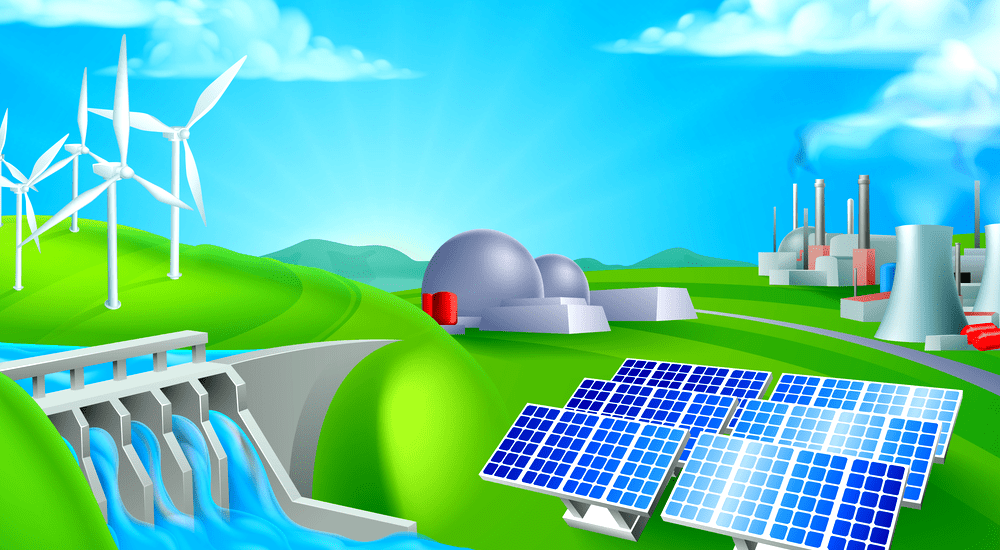Energy Losses in Power Generation
- 26 February 2021
- Posted by: Future Energy
- Category: Energy

Electrification is due to play a major part in the world’s transition to #NetZero. It is forecast that by 2050, electrical production / consumption will virtually double, with total energy usage increasing by 50%.
However over the next 30 years, the losses associated with the conversion of primary energy (conventional fuels and renewables) into electricity are due to remain flat at around 2/3 of the input energy.
In that time renewables materially increase their share of the primary energy source – so are we missing opportunities to increase the efficiency of electrification? Or are renewables inherently as inefficient in their conversion to electricity as conventional sources?
The size of the prize / problem
The EIA released its biennial review of 2050 world energy in 4Q19. While the world, and global energy markets, have witnessed dramatic changes since then, directionally the transition to a doubling of electrical end-usage had already been identified.
By 2050, global energy consumption is forecast to rise by almost 50% to over 960 ExaJoules (EJ) (or 911 Peta-btu (Pbtu)). Of that over 450 EJ (429 Pbtu) – 47% – will be used in the generation of electricity.
Approximately 76% of renewable primary energy will go to creating electricity, along with 100% of nuclear and 57% of coal. Only 34% of natural gas and 3% of petroleum liquids will be used in electrical generation.
However, in creating that 149 EJ (141 Pbtu) of electricity, 67% of the primary energy is forecast to be lost – more than the global electrical primary energy supply today (247 Pbtu). These figures are prior to the approx. 5% traditionally associated with the transmission and distribution losses, along with the subsequent losses existing at the local level (boiler / compressor / motor inefficiencies). Can it be true?
We are grateful to Future Energy Partner for helping us though the ISO certification process. The implementation of ISO standards is what differentiates as a company from our competitors and demonstrates our commitment to Occupational Health and Safety Management.


Understanding the losses
The first question is “where does it all go?”, and the answer for fossil fuels / nuclear is well understood and quantifiable and not open to much debate. However for renewable energy, which by definition is not depleted by use, what constitutes a “loss”?
We are able to measure the power output from renewable sources, and associated losses (e.g. the generator / electrical systems in wind turbines) – but how do we quantify the original primary input energy from e.g. the sun or the wind ?


Unfortunately, there appears to be no clear definition for what a renewable loss is / how it is quantified, and so we shall use the EIA’s figures for consistency – but have differentiated between conventional and renewable sources of losses for the sake of clarity in the graph above.
Conventional
Losses occur in thermal generation plants through the conversion of steam into electricity – there is an inherent loss when heat is converted into mechanical energy to turn the generators. There are additional losses associated with running these plants, about the same level of losses as in the transmission and distribution process – approximately 5%.
However, all such conventional primary energy sources (coal, oil, gas, nuclear) are not as efficient – it is estimated that natural gas plants convert around 45% of the primary input, into electricity, resulting in “only” 55% of energy loss, whereas a traditional coal plant may loose up to 68%.
While the demise of coal is often reported, absolute global volumes are due to stay flat in the next 30 years – though in relative terms declining from 37% today to 23% by 2050.
And just as the new coal plants in India and China will volumetrically offset the general OECD retirement of older, less efficient plants – a net overall increase in efficiency is expected from those new plants.
And what about nuclear? Well, the losses there are about the same as a traditional coal / gas generators at around 35% efficiency, because those plants are subject to the same basic rules of thermodynamics.
Renewables
With the caveat mentioned above regarding the definition and use of the terms “efficiencies” and “losses” for renewable energy, reputable sources have none-the-less published such data – and the figures vary dramatically across those primary inputs.
Some, like hydro-electric, suffer from the same limitations as thermal plants in converting mechanical rotation into electricity – however, as they lack the major input in thermal plants – heat – the losses are a lot, lot less – efficiency can be as high as 80% – though clearly large scale hydro-electric plants cannot be built anywhere.
Solar energy conversion efficiency is limited in photovoltaics to a theoretical 50% due to the primordial energy of the photons / their interactions with the substrates, and currently depending upon materials and technology used, efficiencies of 15-20% are typical.
Wind power is generally 30-45% efficient – also with a maximum efficiency of about 50% being reached at “peak wind” – and a (current) theoretical maximum efficiency of 59.3% – being projected by Albert Betz in 1919.
Care is needed when categorising Geothermal energy efficiency – as installers may promise 400% efficiency (likening “free” geothermal to traditional sources) compared to more established papers citing just over 10% efficiency – another indication of the need to understand the underlying defining principles.
Geothermal currently comprises less than 1% of the United States primary energy generation – with the Geysers Geothermal Complex in California being the biggest in the world having around 1GW of installed capacity (global capacity is currently around 15GW) – however growth in both efficiency and absolute volumes can be expected.
The most efficient renewable energy is Tidal, where it is estimated that 80% of the kinetic energy is converted into electricity. Currently small in scale (less than 3GW globally), it is believed that tidal energy technology could deliver between 120 and 400GW, where those efficiencies can provide meaningful improvements to overall global metrics.
Comparing such data for renewables, it becomes easier to fundamentally question what has actually been expended in the conversion to electricity, and therefore “lost” in the conversion to electricity – isn’t it Renewable after all?
Conclusions
Inherently the laws of physics and chemistry limit the energy conversion efficiency of conventional thermal electrical power sources, sources that will still provide almost 50% of the electricity produced in 2050. Efficiencies in how that thermal / mechanical energy is converted to electrons will undoubtedly come in the next 30 years, but it is unlikely that quantum leaps in such technology will occur.
Those same laws govern estimates of the contribution / energy efficiency of all of the renewable primary energy sources also, and it is just that, an estimate, though it is probably fair to say that Tidal and Hydroelectric are forecast to be by far the most efficient in their conversion to electricity (~80%). However their relatively small-scale deployment limits their ability to move the global efficiency needle.
Therefore, as Solar and Wind are due to produce ~37% of the future total primary energy inputs for electricity, yet whose efficiencies average around 30% – it would appear that they provide the world with the largest opportunity to reduce the such substantial losses, no matter how defined, as we push forward with increased electrification. Where those gains can come from, at what price, and when, is yet to be defined.
Future Energy Partners provides clean energy options and practical solutions for clients. We pride ourselves in being a consultancy that is dedicated to bringing the supply of energy that is required in today’s modern world in a responsible and professional manner, with due recognition of the global challenges facing society and a detailed understanding of the business imperatives.
Leave a Reply Cancel reply
You must be logged in to post a comment.
